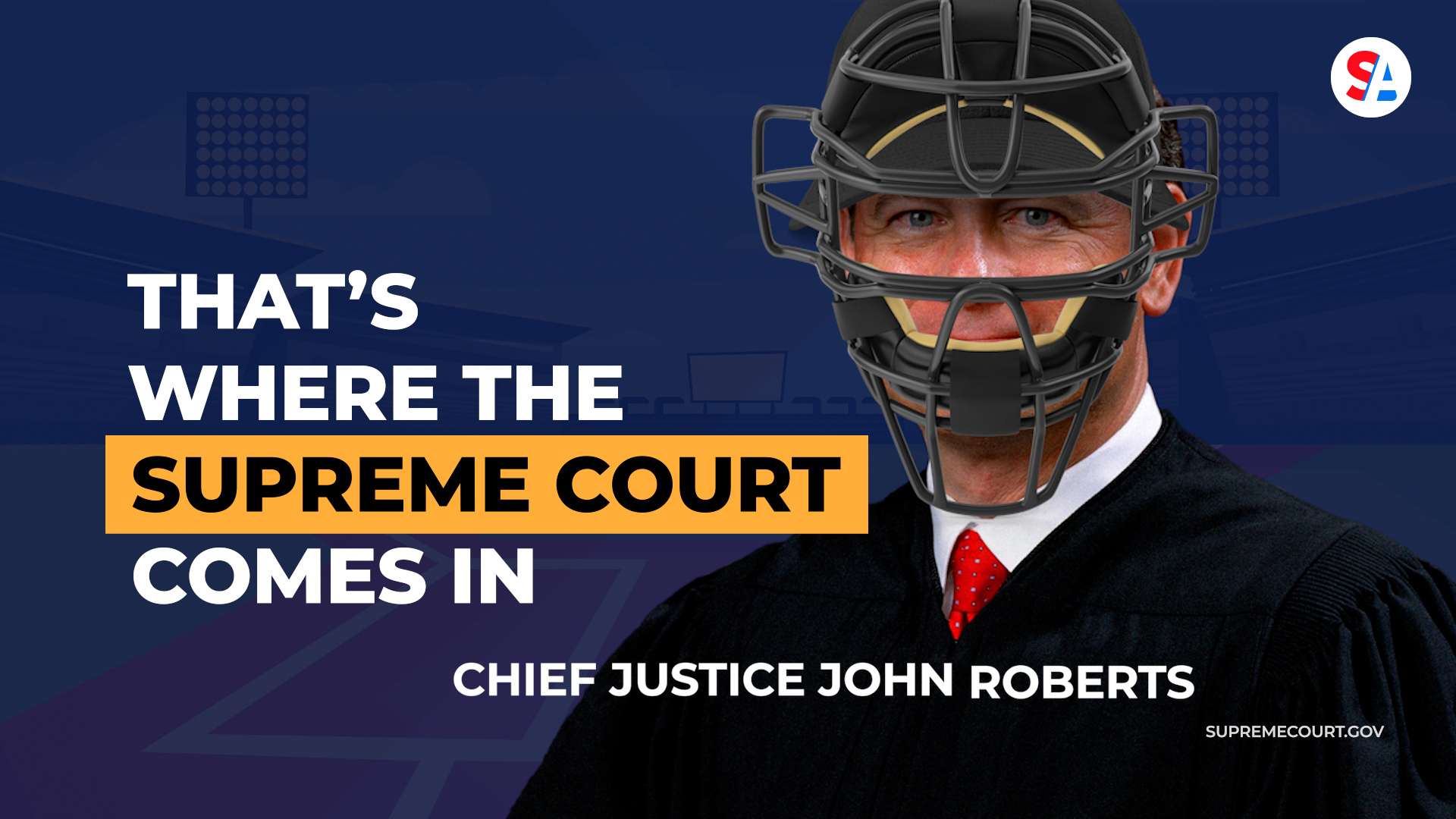
Supreme Court Justices as umpires? History says otherwise
Annie Andersen: FANS OF THE U.S. CONSTITUTION PRIDE THEMSELVES ON THE
CONCEPT OF BALANCE OF POWER AMONG THE THREE BRANCHES OF GOVERNMENT.
THE LEGISLATIVE BRANCH CAN RAISE TAXES, AMEND THE CONSTITUTION AND ENACT LAWS.
THE EXECUTIVE BRANCH CAN VETO THEM, CONTROL THE MILITARY AND APPOINT JUDGES
AND THE JUDICIAL BRANCH CAN DECLARE LAWS AND PRESIDENTIAL ACTIONS UNCONSTITUTIONAL AND OVERTURN AMENDMENTS.
IT’S THESE CHECKS AND BALANCES THAT MAKE SURE NO ONE HAS ULTIMATE POWER.
BUT THROUGHOUT OUR HISTORY, PRESIDENTS HAVE BEEN TRYING TO STACK THE COURT IN THEIR FAVOR.
I DO NOT HAVE ACCESS TO ENVATO, SO CAN SOMEBODY PULL VIDEO TO GO WITH THIS SOUND PLS
FANS OF BASEBALL WILL APPRECIATE THIS NEXT ANALOGY.
IF POLITICS ARE LIKE BASEBALL…
THE TEAMS WOULD BE THE WHITE HOUSE AND CONGRESS… THE BATS AND BALLS- LEGISLATION.
THAT LEAVES THE UMPIRE… AND CHIEF JUSTICE JOHN ROBERTS SAYS THATS WHERE THE SUPREME COURT COMES IN.
Chief Justice John Robert: <<“Judges are like umpires. Umpires don’t make the rules, they apply them. The role of an umpire and a judge is critical. They make sure everybody plays by the rules, but it is a limited role. Nobody ever went to a ball game to see the umpire.”>>
Annie Andersen: CURRENTLY, THE SUPREME COURT HAS 6 CONSERVATIVE JUDGES AND 3 MORE LIBERAL ONES.
Sean WalkupCAN YOU MAKE A GFX FOR THIS AS WELL PLS
ACCORDING TO SCOTUS BLOG: 43% OF RECENT CASES WERE UNANIMOUS. THAT’S DOWN JUST A BIT FROM THE 46% AVERAGE OVER THE PAST DECADE.
15% OF THE CASES WENT ALONG PARTY LINES – WITH THE 6 REPUBLICAN APPOINTED JUDGES VOTING ONE WAY AND THE 3 DEMOCRATIC JUDGES THE OTHER WAY.
WHICH IS WHY PRESIDENTS TRY TO STACK THE COURT.
HISTORY FANS, LIKE MY PRODUCER, ARE GOING TO LIKE THIS NEXT PART.
IT ALL STARTED BACK IN 1801 WITH WHAT’S CALLED THE MIDNIGHT JUDGES ACT.
THEY WERE CALLED THAT BECAUSE PRESIDENT JOHN ADAMS WAS SAID TO BE SIGNING THEIR APPOINTMENTS AT MIDNIGHT PRIOR TO
PRESIDENT THOMAS JEFFERSON’S INAUGURATION.
CONGRESS ADDED 16 JUDGES TO CHANGE HOW FEDERAL COURTS WORKED.
KEEP IN MIND THERE WERE ONLY 13 AT THE TIME AND THAT INCLUDED THE SUPREME COURT.
AND WITH JUST 19 DAYS LEFT IN HIS PRESIDENCY… JOHN ADAMS QUICKLY STARTED FILLING THOSE SPOTS- WITH MEMBERS OF HIS OWN PARTY OF COURSE.
THE CHANGES WERE SHORT LIVED AS THE BILL WAS REPEALED A YEAR LATER– BUT THE POLITICS WERE FAR FROM OVER .
FAST FORWARD ABOUT 40 YEARS.. PRESIDENT JAMES POLK APPOINTED HIS CAMPAIGN ADVISOR TO THE SUPREME COURT.
IN 1869, CONGRESS EXPANDED THE SUPREME COURT TO 9 JUSTICES.
THE FOLLOWING CENTURY, PRESIDENT FRANKLIN D. ROOSEVELT TRIED TO ADD SIX MORE JUSTICES TO THE SUPREME COURT-
AFTER THE COURT STRUCK DOWN MUCH OF HIS NEW DEAL PLAN.
BUT THAT DIDN’T HAPPEN.
ENOUGH HISTORY- LET’S SKIP ALONG A FEW DECADES TO MODERN TIMES.
RESEARCHERS FROM WILLIAM AND MARY UNIVERSITY ALONG WITH OHIO STATE UNIVERSITY SAID
THE POLITICS OF THE SUPREME COURT HAVE GROWN IN THE PAST DECADE, SAYING ”PRESIDENTS — FOR THE FIRST TIME EVER — MAKE IDEOLOGY THE DOMINANT FACTOR IN APPOINTING JUSTICES. THE SENATE CONFIRMATION PROCESS TOO PAYS INCREASING ATTENTION TO IDEOLOGY, INCLUDING PARTY LINE VOTES THAT BLOCK THE CONSIDERATION OF JUDICIAL NOMINEES.”
IN MARCH 2016 MERRICK GARLAND SHED TEARS AS PRESIDENT BARACK OBAMA ANNOUNCED HIS NOMINATION TO THE SUPREME COURT.
Merrick Garland: “Fidelity to the constitution and the law has been the cornerstone of my professional (cries) life.”
Annie Andersen EXCEPT… REPUBLICANS HELD THE SENATE AND THEN MAJORITY LEADER MITCH MCCONNELL DECIDED GARLAND WOULDN’T GET A CONFIRMATION HEARING —
WITH IT BEING AN ELECTION YEAR AND ALL.
THE LIBERTARIAN CATO INSTITUTE CALCULATES 60 PERCENT OF JUSTICES HAVE BEEN CONFIRMED UNDER A DIVIDED GOVERNMENT.
GARLAND WOULD NOT BE ONE OF THEM.
AND SO THE POLITICS CONTINUED.
WHILE CAMPAIGNING, THEN CANDIDATE DONALD TRUMP SPOKE ABOUT THE SUPREME COURT AT A DEBATE:
Chris Wallace: <<”I would ask you specifically, do you want the court, including the justices that you will name, to overturn Roe v. Wade which includes, in fact states, a woman’s right to abortion.”>>
President Donald Trump: <<” Well, if that would happen because I am pro-life, and I will be appointing pro-life judges,”>>
Annie Andersen: PRESIDENT TRUMP CONFIRMED THREE JUSTICES WHILE IN OFFICE –EVEN IN AN ELECTION YEAR.
PRESIDENT JOE BIDEN MAY CONFIRM A FEW AS WELL.
JUSTICE BREYER IS 82 AND SOME PROGRESSIVES WANT HIM TO RETIRE SO BIDEN CAN FILL HIS SEAT WITH A YOUNGER PERSON.
AND BIDEN IS CONSIDERING EXPANDING THE SUPREME COURT.
IN APRIL HE CALLED FOR A 6-MONTH STUDY TO LOOK INTO IT.
ALL EYES WILL BE ON THE COURTS IN THE FALL WHEN ABORTION RIGHTS WILL BE RECONSIDERED. THE SUPREME COURT WILL HEAR A CASE FROM MISSISSIPPI BANNING MOST ABORTIONS AFTER 15 WEEKS.
DID WE EXPLAIN THIS WELL? –I DARE SAY, IT’S A HOME RUN?
LET US KNOW IN THE COMMENTS BELOW. AND DON’T FORGET TO GO TO OUR PAGE TO RATE THIS STORY USING OUR BIAS METER.
Unbiased news. Directly to your inbox. Free!
Learn more about our emails. Unsubscribe anytime.





